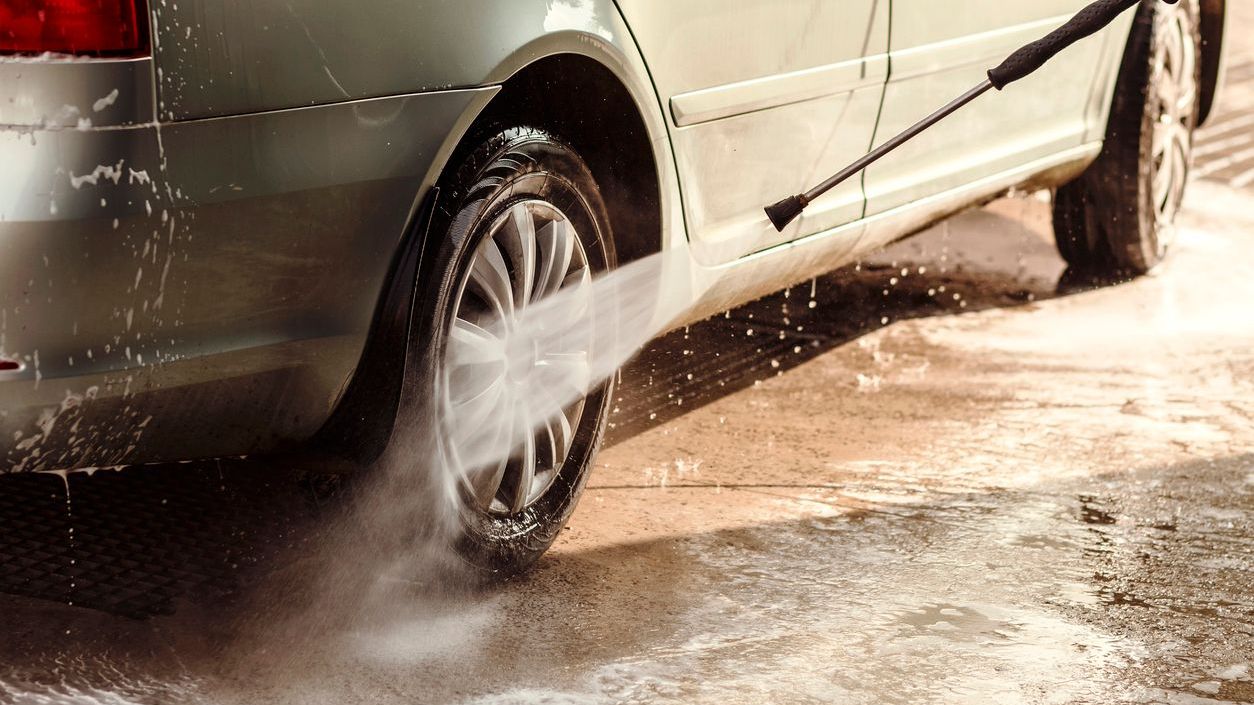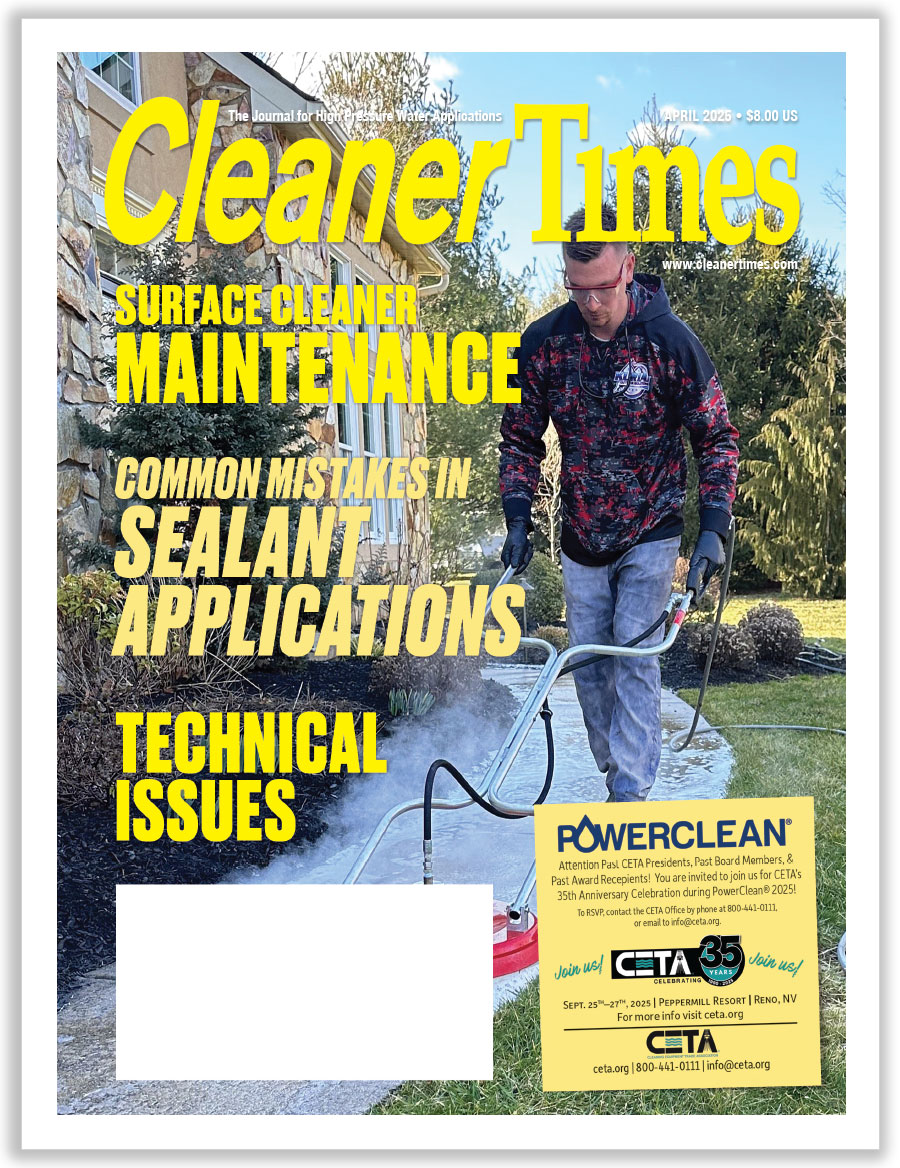
Car Wash Tools
By Diane Calabrese / Published April 2024

Ultrasonic showers will be the future if life imitates art (in this case, science fiction). Already in use are ultrasonic cleaners for high-end auto parts (plus precision applications elsewhere).
What about the in-between: ultrasonic cleaners for the exterior of vehicles? We’re not there yet.
Even so, the tools for washing cars go well beyond buckets and cloths and water. Adoption of steam for cleaning and detailing continues to grow, for example.
Those engaged in the day-to-day sphere of car washes—whether contractors, distributors or manufacturers—most likely have a magic-wand tool in mind. What would they conjure up instantly if they could?
“An endless supply of deionized water for mobile washing,” says Michael Hinderliter, president of Steamaway Inc. in Fort Worth, TX. Water that’s exclusively water (i.e., no salt ions, minerals, or carbon dioxide in solution) makes it much easier to achieve a beautiful outcome.
Deionized water may be used without chemicals. If chemicals are added to deionized water, they do not get diminished or altered by ions already in solution. The positives attached to deionized water just begin there.
Better adhesion of wax and no residual odor are two other plusses tied to the use of deionized water in car washing. “Coveted” may be too strong a word to describe the view of deionized water by car washes striving for outstanding results, but tools to give contractors all the deionized water they require are certainly wanted—and an opportunity for manufacturers and distributors.
Match the tool to the task. We know the adage: holding a hammer does not mean everything is a nail.
So it is with car wash tools. Just because an operator is holding a wand, it does not mean it should be used to apply water (and chemical) to every part of a vehicle.
A mix of wands, automated brushes, carriages, and tunnels have carried the car wash industry beyond buckets and cloths. It continues to benefit from modification. Members of the industry have suggestions about what some of the changes should be.
Aaron Lindholm is president and CEO of Veloci Performance Products in Burnsville, MN, and cites one tool that is very welcome in the industry. “The Morelite Plug and Dry system of brushes for rollover and tunnel equipment has the maintenance and operator in mind,” he says.
The system keeps “brushes clean and cars maintained much more efficiently,” explains Lindholm. “Carwash drying systems have been the same for a long time, and this new system is truly innovative.”
There are still plenty of components that ought to get the attention of designers, though. One is “a tool that would clean wheels better,” says Lindholm. “I always feel like my wheel wells are dirty and don’t get the attention that they deserve.”
Ensuring that every part of a vehicle receives the attention it requires is one part of the equation for determining how to carry the industry forward.
LOGISTICS OF CAR WASHES GET A LOT OF ATTENTION. OPTIMAL SCHEDULING OF CUSTOMERS THAT ELIMINATES WAITING IS ONE GOAL. EFFICIENT MOVEMENT THROUGH A WASH EXIT IS ANOTHER. THERE ARE NOW MYRIAD SOFTWARE PACKAGES ON THE MARKET THAT ALLOW A WASH OWNER TO MEET BOTH OBJECTIVES.
The companion part of the equation is the adjustment to existing tools to make them easier to use and maintain.
Car wash tools include a big matrix of ancillaries. The ancillaries include PPE [personal protective equipment] for machine operators, oil water separators, drain covers, devices for cleaning drains, and so on. Systems that capture, clean, and recycle wastewater on site are desired at least as much as a constant supply of deionized water.
Licensing entities (state and local) for car wash facilities apply considerable scrutiny to the businesses. A commercial wash may want to welcome vehicles used to apply pesticides or herbicides.
But in many places, the wash owner must verify the vehicle has been decontaminated by a registered applicator of such chemicals. Even then, separate bays may be required for the washing.
Whether a rollover, tunnel, or wand car wash, increasingly the goal at each is a closed-loop recycle system for water. Any tool that makes it easier to achieve
100 percent on-site recycling pushes the sector to a higher and notable level.
Of course, any tool—from deionized water to exacting brushes—that reduces the amount of water required to clean each vehicle is welcome. Steam reduces the amount of water needed considerably.
If steam cleaning requires only about two gallons of water per car, and a water wash requires approximately 40 gallons, why has the move toward steam been less than fast? Several reasons explain it. Among them are dirty exteriors that require something more (e.g., water flow, chemicals), cost, and safety of workers.
The broadest definition of a car wash tool backs up to the car manufacturer. Advances in coatings aimed at making it easier to keep cars clean are in the mix.
At the same time, protective coatings following a wash now extend beyond wax. A graphene coating repels water and contaminants as does wax. But graphene advocates believe it does so better than waxes can.
Next to water capture and recycling, maintenance of structures (e.g., tunnel, conveyors) at wash sites might be the most vexing issue. Manufacturers keep introducing tools that make maintenance incrementally easier. Among them are pivot points that require no lubrication and an overall reduction in the number of moving parts.
Logistics of car washes get a lot of attention. Optimal scheduling of customers that eliminates waiting is one goal. Efficient movement through a wash exit is another. There are now myriad software packages on the market that allow a wash owner to meet both objectives.
Along with operational software, there are plenty of CRM [customer relationship management] programs. Such tools may be useful in retaining customers and obtaining feedback that informs changes.
Things work quite satisfactorily at car washes. A dirty car enters and a notably clean one leaves.
Improvement is always possible, though. Consider reverse osmosis (RO) equipment used in some on-site water collection and recycling systems. Extending the longevity of RO systems is key to making the tools cost-effective for the owner of a car wash.
An RO system requires proper routine maintenance (e.g., changing micro filters on schedule) and testing (to make certain it’s working properly). Chlorine—if there is any in the water captured—can damage the filters. As such, expect more refinement of this tool over time.
Ultra-filtration (UF) systems also may be used in car washes. Right now, the literature indicates they are more popular outside the United Sates.
Neither RO nor UF systems take water to just hydrogen and oxygen. But the tools get closer and closer to doing so with continuous improvements.
We mentioned steam cleaning in conjunction with car washes, especially the inside of a vehicle. Vacuums must also be included on a list of car wash tools. They still get the nod in the predominant number of instances when both interiors and exteriors are cleaned.
The car wash itself may be viewed as a tool when it comes in the form of a kit. Some manufacturers offer setups with canopies, water collection pads, and a cold-water pressure washer with wand.
Although we have found no source suggesting special precautions when washing electric vehicles, the EVs may nudge the development of new tools. The weight of EVs will over time add more to the wear of both conveyors and the mechanisms that move them. Conveyors capable of handling a steady flow of heavy vehicles instead of just the occasional EV will be needed.
Car wash tools mirror the tools in other industries. They are designed to bring excellent results and to do so while using the minimum amount of water, chemicals, energy, and time.
Ultrasonic cleaning? Someday, probably.





